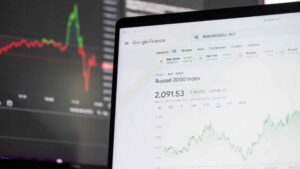The US Dollar continues to stay in the FX market spotlight as its volatility ramps up, caused by various factors such as the Fed’s policies, geopolitical events, and market sentiment.
Recent developments such as the peace talks over the Russia-Ukraine war, a rate cut from the RBNZ, President Trump’s tariffs, Fed policy, and mixed economic data have all impacted market sentiment around the US Dollar.

Source: TradingView
Peace Talks in Saudi Arabia
US and Russian delegates have met in Riyadh, KSA, to discuss terms on how to end the war in Ukraine, which has brought supply chain disruptions and high inflation for the past 3 years.
The peace talks pushed markets slightly toward a risk-on mood, reflecting some hope that conflict could end soon. As a result, safe-haven outflows increased, where traders preferred riskier assets such as currencies against the USD. ⁽¹⁾
If the peace talks do make some major breakthroughs, the US Dollar could face further bearish pressure.
However, the peace talks in Saudi Arabia have sparked some controversy, as no Ukrainian or European officials were present at the negotiations—raising some doubts about their legitimacy.
Ukrainian President Volodymyr Zelenskyy stated that Ukraine was not invited, accusing Trump of operating in a “disinformation bubble” influenced by Moscow. In response, Trump escalated tensions further, referring to Zelenskyy as a “dictator without elections,” souring relations further between the two leaders.
With Ukraine excluded and rhetoric intensifying, the prospects for a meaningful breakthrough still remain uncertain.
Central Bank Policies
The Reserve Bank of New Zealand has cut interest rates by 50 bps, which was expected by markets. The RBNZ has taken a dovish stance, focused on stimulating economic growth after five straight quarters of declining GDP.
NZD/USD rebounded despite RBNZ’s dovish stance. The rebound was likely caused by USD weakness ahead of the FOMC Minutes as traders await insights regarding their monetary policy outlook. ⁽²⁾
The Federal Reserve is being cautious in its approach to interest rates, which kept the US Dollar stable. January’s CPI report showed that inflation pushed higher to 3% as new tariff fears sparked inflationary pressures and could support the Fed’s hawkish stance. Overall, this could potentially support a US Dollar rebound in the long term. ⁽³⁾
More Tariffs and Rate Cut Demands
President Trump announced during his interview with Fox News on February 18 that he would impose tariffs starting at 25% on automobiles, pharmaceuticals, and semiconductor chips.
No date was announced, although he plans to increase these tariffs to force companies to invest in the US. At the same time, he announced a March 12 start date for 25% tariffs on steel and aluminium.
While the news didn’t deliver an immediate effect on the US dollar, implementing reciprocal tariffs could add bullish momentum to the greenback and affect the competitiveness of American companies. ⁽⁴⁾
President Trump has been vocal in his belief that the Fed should lower interest rates. He publicly stated that he would “demand” interest rates to drop.
Trump has criticized the Fed’s timing on interest rate decisions, saying they tend to be “a little bit too early and a little bit too late.”
Despite Trump’s pressure, Fed Chair Jerome Powell has maintained that the Fed is independent, and that political pressure will not influence monetary policy decisions. ⁽⁵⁾
Economic Data is Showing an Uncertain Path
Economic data has shown mixed sentiment. Earlier in February, January NFP January came in lighter than expected, but the unemployment rate and wage growth showed better than expected numbers.
Inflation figures (CPI and PPI) also came in hotter than expected, which supported the Fed’s hawkish stance on cautiously moving interest rates. Retail sales reported disappointing numbers that weighed heavily on USD performance.
Upcoming economic data such as flash services & manufacturing PMIs, consumer confidence, and GDP will likely trigger volatility in the US Dollar and provide further insights on the Fed’s next moves on interest rates.


